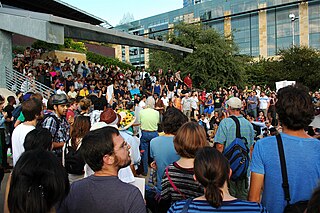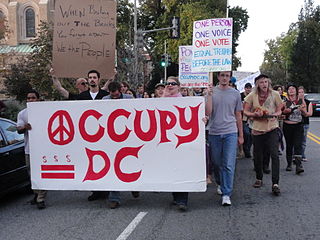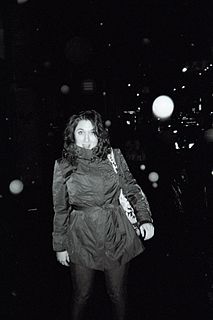
Zuccotti Park, formerly called Liberty Plaza Park, is a 33,000-square-foot (3,100 m2) publicly accessible park in Lower Manhattan, New York City, located in a privately owned public space (POPS) controlled by Brookfield Properties and Goldman Sachs. The park was created in 1968 by Pittsburgh-based United States Steel, after the property owners negotiated its creation with city officials. It was named Liberty Plaza Park because it was situated beside One Liberty Plaza, which is located between Broadway, Trinity Place, Liberty Street, and Cedar Street. The park's northwest corner is across the street from Four World Trade Center. It has been popular with local tourists and financial workers.

Ydanis Rodríguez is the Council member for the 10th District of the New York City Council. He is a Democrat. The district includes Washington Heights, Inwood, and Marble Hill in Manhattan. Rodríguez serves as the Chairman of the Council Transportation Committee. He is known for his arrest at an Occupy Wall Street rally in November 2011, and was profiled for the act in Time's 2011 Person of the Year.

Occupy Los Angeles is one of the many occupy movements in the United States, following the original Occupy Wall Street (OWS) protest. Participants of Occupy L.A. first met at Pershing Square on September 23, 2011. Activists came to consensus to occupy public space in solidarity with the growing movement. Occupiers first marched in Los Angeles on September 24, 2011. They next protested a fundraiser being held in Hollywood at the House of Blues for President Obama. Participants met at Pershing Square every subsequent night to plan out the logistics of an occupation set to begin on October 1, 2011. After debating potential locations around Los Angeles, people decided on the lawns around City Hall. Tents first manifested on October 1, 2011 on the grounds of Los Angeles City Hall.

The following is a brief timeline of Occupy Wall Street (OWS), a protest which began on September 17, 2011 on Wall Street, the financial district of New York City and included the occupation of Zuccotti Park, where protesters established a permanent encampment. The Occupy movement splintered after NYC Mayor Bloomberg had police raid the encampment in Zuccotti Park on November 15, 2011. The timeline here is limited to this particular protest during this approximate time-frame.

Occupy Austin was a collaboration that began on October 6, 2011 at City Hall in Austin, Texas as an occupation and peaceful protest. It is affiliated with the Occupy Wall Street movement that began in New York City, and also with the "Occupy" protests in the United States and around the world. At the center of the occupation is the General Assembly, where the community comes out and tries to come to consensus on proposals for action.

Occupy Chicago was an ongoing collaboration that included peaceful protests and demonstrations against economic inequality, corporate greed and the influence of corporations and lobbyists on government which began in Chicago on September 24, 2011. The protests began in solidarity with the Occupy Wall Street protests in New York.

The 15 October 2011 global protests were part of a series of protests inspired by the Arab Spring, the Icelandic protests, the Portuguese "Geração à Rasca", the Spanish "Indignants", the Greek protests, and the Occupy movement. The protests were launched under the slogan "United for #GlobalChange", to which the slogan "United for Global Democracy" was added by many people's assemblies. The protest was first called for by the Spanish Plataforma ¡Democracia Real YA! in May 2011 and endorsed by people's assemblies across the world. Reasons were varied but mainly targeted growing economic inequality, corporate influence over government and international institutions, and the lack of truly democratic institutions allowing direct public participation at all levels, local to global. Global demonstrations were held on 15 October in more than 950 cities in 82 countries. The date was chosen to coincide with the 5-month anniversary of the first protest in Spain. General assemblies, the social network n-1, mailing lists, Mumble voice chat, open pads such as Pirate Pad and Titan Pad, and Facebook were used to coordinate the events. Some protests were only a few hundred in number, whereas others numbered in the hundreds of thousands, with the largest in Madrid numbering half a million and the second largest city Barcelona with 400,000.

Occupy D.C. was an occupation of public space in Washington, D.C. based at McPherson Square and connected to the Occupy movements that sprung up across the United States in Fall 2011. The group had been demonstrating in McPherson Square since October 1, 2011, and in Freedom Plaza since October 6. Despite crackdowns on other Occupy projects across the country, federal authorities claimed on November 15 that they have no plans to clear McPherson Square Park. The National Park Service decided against eviction after meeting with activists and discussing health and safety conditions.

The 99 Percent Declaration or 99% Declaration is a not-for-profit organization based in Kentucky that originated from a working group of the Occupy Wall Street (OWS) movement in Zuccotti Park, New York City, in October 2011. The organization published a document calling for a "National General Assembly" to be held beginning the week of July 4, 2012 in Philadelphia, which was rejected by the general assemblies of OWS and Occupy Philadelphia. The Declaration includes demands for an immediate ban on all monetary and gift contributions to all politicians, implementation of a public financing system for political campaigns, and the enactment of an amendment to the United States Constitution overturning the Supreme Court's Citizens United v. FEC decision.

The Occupy movement began in the United States initially with the Occupy Wall Street protests but spread to many other cities, both in the United States and worldwide. This list article is a summary of occupy events that have occurred in cities in the United States.

Timothy Daniel Pool is an American journalist, YouTuber, and political commentator. He is best known for livestreaming the Occupy Wall Street protests in 2011.

The People's Library, also known as Fort Patti or the Occupy Wall Street Library, was a library founded in September 2011 by Occupy Wall Street protesters in lower Manhattan's Zuccotti Park located in the Financial District of New York City. It was temporarily evicted when Zuccotti Park was cleared on November 15, 2011, during which time 5,554 books were thrown away by the New York City Police Department. In April 2013, the Government of New York City was ordered to pay $366,700 for the raid, which was found to have violated the protesters' First, Fourth and Fourteenth Amendment rights.

General assemblies (GA) were the primary decision making bodies of the global Occupy Movement which arose in 2011. Open to all who wished to take part, general assemblies allowed for an inclusive form of direct democracy. Such assemblies aimed to establish a consensus among all participants.
The Occupy Wall Street demonstrations garnered reactions of both praise and criticism from organizations and public figures in many parts of the world. Over time, a long list of notable people from a range of backgrounds began and continue to lend their support or make reference to the Occupy movement in general.
The Occupy movement has been met with a variety of responses from local police departments since its beginning in 2011. According to documents obtained by the Partnership for Civil Justice Fund, the FBI, state and local law enforcement officials treated the movement as a potential criminal and terrorist threat and used fusion centers and counterterrorism agents to investigate and monitor the Occupy movement.

The Occupy the Hood movement is a nationwide grassroots movement in the United States that is an extension of Occupy Wall Street and of the Occupy Movement generally. The movement started in response to how the Occupy Wall Street movement was developing after its initial encampment in Zuccotti Park. Occupy the Hood seeks to represent the interests of oppressed people and to bring people of color into the Occupy Movement. The movement has been especially active in its attempts to decolonize the Occupy Movement. Occupy the Hood was created by Malik Rhasaan, from Jamaica, Queens. Occupy the hood chapters exist in the U.S. cities of Atlanta, Boston, Indianapolis, Los Angeles, Milwaukee, New York City, New York, and other major metropolitan cities.

Occupy Sandy is an organized relief effort created to assist the victims of Hurricane Sandy in the northeastern United States. Like other Occupy Movement offshoots, such as Occupy Our Homes, Occupy University, Occupy the SEC, and Rolling Jubilee, Occupy Sandy is made up of former and present Occupy Wall Street protesters, other members of the Occupy movement, and former non-Occupy volunteers. The effort has worked in partnership with many local community organizations in New York City and New Jersey and has focused on mutual aid in affected communities rather than charity, and long-term rebuilding for more robust, sustainable neighborhoods.

Cecily McMillan is an American activist and advocate for prisoner rights in the United States who was arrested and subsequently convicted of felony second-degree assault after assaulting a New York City Police officer as he led her out of the Occupy Wall Street protest in Zuccotti Park on March 17, 2012. McMillan's highly publicized arrest and trial led to her being called a "cause célèbre of the Occupy Wall Street movement". McMillan claimed that her breast was grabbed and twisted by someone behind her, which she claims to have responded to by reflexively elbowing her perceived attacker in the face. The officer involved, Grantley Bovell, testified that she deliberately assaulted him, a claim supported by video evidence showing McMillan "bending her knees, then throwing her right elbow into the officer's eye". She was arrested after a brief attempt to flee, and claims to have been beaten by police during her arrest. McMillan was convicted of felony second-degree assault on May 5, 2014, and was subsequently sentenced to three months in prison and five years of probation.



















